- Clone
- Bu32 (See other available formats)
- Regulatory Status
- RUO
- Workshop
- V CD21.4, VI CD21.5
- Other Names
- Complement C3d receptor (C3dR), complement receptor 2 (CR2), Epstein-Barr virus receptor
- Isotype
- Mouse IgG1, κ
- Ave. Rating
- Submit a Review
- Product Citations
- publications
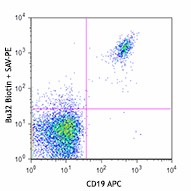
-

Human peripheral blood lymphocytes were stained with CD19 APC and biotinylated CD21 (clone Bu32) (top), or biotinylated mouse IgG1, κ isotype control (bottom), followed by Streptavidin PE. -

| Cat # | Size | Price | Quantity Check Availability | Save | ||
|---|---|---|---|---|---|---|
| 354913 | 50 µg | 112 CHF | ||||
CD21 is a 145 kD transmembrane protein also known as complement C3d receptor (C3dR), complement receptor 2 (CR2), and Epstein-Barr virus receptor. CD21 is expressed on B cells, follicular dendritic cells, subsets of normal thymocytes and T cells, and some epithelial cells. CD21 is the receptor used by Epstein-Barr virus to infect B cells and is also the complement receptor for C3d. CD21 has also been shown to interact with a number of proteins, including CD23, CD19, annexin VI, CD81, iC3b, complement receptor 1 (CR1, CD35), and interferon-alpha 1 (IFN-α1).
Product DetailsProduct Details
- Verified Reactivity
- Human
- Reported Reactivity
- African Green, Baboon, Cynomolgus
- Antibody Type
- Monoclonal
- Host Species
- Mouse
- Formulation
- Phosphate-buffered solution, pH 7.2, containing 0.09% sodium azide.
- Preparation
- The antibody was purified by affinity chromatography and conjugated with biotin under optimal conditions.
- Concentration
- 0.5 mg/ml
- Storage & Handling
- The antibody solution should be stored undiluted between 2°C and 8°C. Do not freeze.
- Application
-
FC - Quality tested
- Recommended Usage
-
Each lot of this antibody is quality control tested by immunofluorescent staining with flow cytometric analysis. For flow cytometric staining, the suggested use of this reagent is ≤0.5 µg per million cells in 100 µl volume. It is recommended that the reagent be titrated for optimal performance for each application.
- Application Notes
-
Additional reported applications (for the relevant formats) include: immunohistochemical staining of acetone-fixed frozen sections4.
-
Application References
(PubMed link indicates BioLegend citation) -
- Björck P, et al. 1993. Eur. J. Immunol. 23:1771.
- Frémeaux-Bacchi V, et al. 1996. Eur. J. Immunol. 26:1497.
- Ling NR, et al. 1995. Clin. Exp. Immunol. 101:369.
- Wang, C, et al. 2011. BMC Immunol. 12:53. (IHC)
- Product Citations
-
- RRID
-
AB_2564560 (BioLegend Cat. No. 354913)
Antigen Details
- Structure
- Transmembrane protein, multiple SUSHI domains, approximate molecular weight 145 kD
- Distribution
-
Expressed on B cells, follicular dendritic cells, subsets of normal thymocytes and T cells, some epithelial cells
- Function
- Epstein-Barr virus receptor on B cells used for infection
- Interaction
- CD23, CD19, complement component 3, annexin VI, CD81, iC3b, complement receptor 1, interferon alpha 1
- Ligand/Receptor
- C3d, EBV
- Cell Type
- B cells, Dendritic cells, Epithelial cells, T cells, Thymocytes
- Biology Area
- Cell Biology, Complement, Costimulatory Molecules, Immunology, Innate Immunity, Neuroinflammation, Neuroscience
- Molecular Family
- CD Molecules
- Antigen References
-
1. Kishimoto T, Eds. 1997. Leukocyte Typing VI. Garland Publishing Inc.
2. Moore MD, et al. 1987. Proc. Natl. Acad. Sci. USA 84:9194.
3. Szakonyi G, et al. 2001. Science 292:1725.
4. Weis JJ, et al. 1984. Proc. Natl. Acad. Sci. USA 81:881. - Gene ID
- 1380 View all products for this Gene ID
- UniProt
- View information about CD21 on UniProt.org
Related FAQs
- How many biotin molecules are per antibody structure?
- We don't routinely measure the number of biotins with our antibody products but the number of biotin molecules range from 3-6 molecules per antibody.
Other Formats
View All CD21 Reagents Request Custom Conjugation| Description | Clone | Applications |
|---|---|---|
| Purified anti-human CD21 | Bu32 | FC,IHC-F,IHC-P |
| PE anti-human CD21 | Bu32 | FC |
| APC anti-human CD21 | Bu32 | FC |
| PerCP/Cyanine5.5 anti-human CD21 | Bu32 | FC |
| FITC anti-human CD21 | Bu32 | FC |
| PE/Cyanine7 anti-human CD21 | Bu32 | FC |
| Biotin anti-human CD21 | Bu32 | FC |
| TotalSeq™-A0181 anti-human CD21 | Bu32 | PG |
| APC/Fire™ 750 anti-human CD21 | Bu32 | FC |
| Alexa Fluor® 700 anti-human CD21 | Bu32 | FC |
| PE/Dazzle™ 594 anti-human CD21 | Bu32 | FC |
| TotalSeq™-C0181 anti-human CD21 | Bu32 | PG |
| TotalSeq™-B0181 anti-human CD21 Antibody | Bu32 | PG |
| APC/Cyanine7 anti-human CD21 | Bu32 | FC |
| TotalSeq™-D0181 anti-human CD21 | Bu32 | PG |
| TotalSeq™-Bn0181 anti-human CD21 | Bu32 | SB |
| APC/Fire™ 750 anti-human CD21 | Bu32 | FC |
| Spark Violet™ 423 anti-human CD21 | Bu32 | FC |
| Spark Red™ 718 anti-human CD21 (Flexi-Fluor™) | Bu32 | FC |
Compare Data Across All Formats
This data display is provided for general comparisons between formats.
Your actual data may vary due to variations in samples, target cells, instruments and their settings, staining conditions, and other factors.
If you need assistance with selecting the best format contact our expert technical support team.
-
Purified anti-human CD21
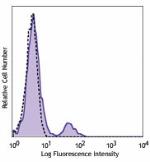
Human peripheral blood lymphocytes were stained with purifie... 
IHC staining of purified anti-human CD21 antibody (clone Bu3... -
PE anti-human CD21
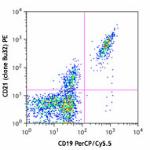
Human peripheral blood lymphocytes were stained with CD19 Pe... 
-
APC anti-human CD21

Human peripheral blood lymphocytes were stained with CD19 FI... 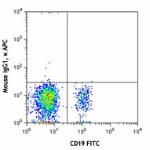
-
PerCP/Cyanine5.5 anti-human CD21

Human peripheral blood lymphocytes were stained with CD19 AP... -
FITC anti-human CD21
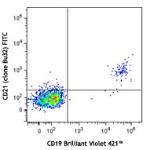
Human peripheral blood lymphocytes were stained with CD19 Br... 
-
PE/Cyanine7 anti-human CD21

Human peripheral blood lymphocytes were stained with CD19 Br... -
Biotin anti-human CD21

Human peripheral blood lymphocytes were stained with CD19 AP... 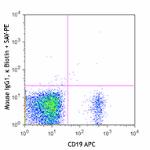
-
TotalSeq™-A0181 anti-human CD21
-
APC/Fire™ 750 anti-human CD21

Human peripheral blood lymphocytes were stained with CD19 BV... -
Alexa Fluor® 700 anti-human CD21

Human peripheral blood lymphocytes were stained with CD19 BV... -
PE/Dazzle™ 594 anti-human CD21

Human peripheral blood lymphocytes were stained with CD19 BV... -
TotalSeq™-C0181 anti-human CD21
-
TotalSeq™-B0181 anti-human CD21 Antibody
-
APC/Cyanine7 anti-human CD21

Human peripheral blood lymphocytes were stained with anti-hu... -
TotalSeq™-D0181 anti-human CD21
-
TotalSeq™-Bn0181 anti-human CD21
-
APC/Fire™ 750 anti-human CD21
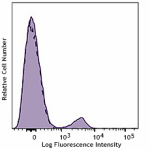
Typical results from human peripheral blood lymphocytes stai... -
Spark Violet™ 423 anti-human CD21

Human peripheral blood lymphocytes were stained with anti-hu... -
Spark Red™ 718 anti-human CD21 (Flexi-Fluor™)
 Login / Register
Login / Register 










Follow Us